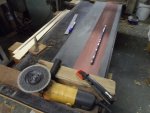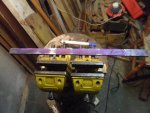You wouldn't need blue stuff, straight edge or feeler gauges you can see where the high points are from the grind marks.
If in doubt use a coarser grit so you can see where you've been.
Hope that helps.
That's the problem you see Jacob, you cannot trust the wear marks as abrasion always favours the ends.
The toe and heel will always be partial to more removal if done on a large lap, and if done like so for long enough,
i.e having to remove a twist, hollow strip in center, or belly in the middle...
(more notably on say a no.5 plane, and worse as you get longer)
then one stands a very good chance of making a banana.
The only way you can trust your eyes and not use feeler gauges is by knowing what flat looks like.
To do so, one must understand the last bit above and use it to ones advantage.
Flat starts with targeted area of removal first, as I don't have an expensive straight edge
I use a lap and markers (couldn't find suitable glass)
Tip for the frugal, if Prussian blue is not deemed essential to me, it gets nice and runny when the plane warms up a few degrees whilst working.
Once the ink can be removed from the toe and heel only, on a large area lap,
with no more than two or three swipes, then you can do what you like after that.
If there's contact somewhere else, then you have to target areas.
Pic below is ink still remaining on the edges of the plane
i.e a slightly hollow, which will disappear with a single rub on the test section (larger area)
I destroyed planes in the past, by doing what you say, as it gets important is there's little meat to play with, adjustable mouth for example,
and there's plenty of job lots on the bay or wherever, that have been treated as such..
I had one of those
That's why one should always seek a plane that can be seen front and back, or as close to it as you can.
Tom




































